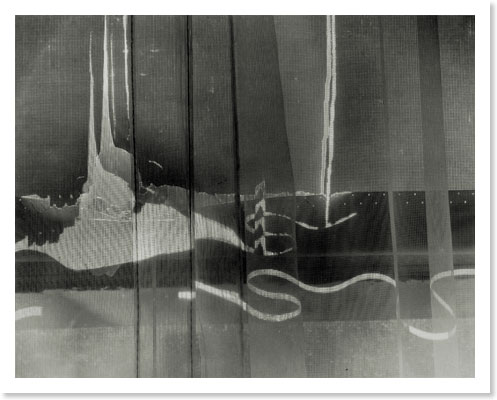
The Language of Light, 1952
by Clarence John Laughlin
Many of Clarence John Laughlin’s Photographs actually show ghosts: transparent but nonetheless corporeal ladies draped in sheets or period nightgowns, appearing from behind stone monuments or Ionic columns or other decaying relics of the Old South. In other of Laughlin’s pictures, like the one shown here, the ghosts have fled, and only the pattern of their spell remains.
Any child abed in lazy and luxurious convalescence from measles or chicken pox, half-drunk with tea and hot lemonade, learns that the space between the window shade and the casement is a magic place, populated by spirits that cast their shifting, liquid shadows on the screen and tap out their secret messages on the window frame. Once each of us was open to such dramas of the senses, revealed in terms that were trivial and ephemeral: the reflection of the hand mirror on the dressing table, slowly tracing its elliptical course across the ceiling.
Many of us forget the existence of such experiences when we learn to measure the priorities of practical life; some of us remember their existence but find that in the light of day they have become as shy and evasive as the hermit thrush; a few, whom we call artists, maintain an easy intimacy with the wonders of simple perception. In this century many of these have been photographers, and the exploration of our fundamental sensory experience has been in large part their work. It is photography that has continued to teach us of the pleasure and the adventure of disinterested seeing.
— John Szarkowski
A month ago I stumbled upon a summer reading list from David Schonauer, editor-in-chief at American Photo. There he states his intent to reread the “best book on photography ever written,” a collection that had been passed down to him years earlier by the out-going founding editor of the magazine, Sean Callahan. “It’s been sitting on a bookcase shelf in my office for years and years, dog-eared and finger-smudged from constant referencing,” Schonaeur writes. “This summer I’m going to pick it up again and look at it closely, from beginning to end. It will be like discovering the magic of photography all over again.”
Curious, I walked over to the library and checked out its copy of Looking At Photographs: 100 Pictures from the Collection of the Museum of Modern Art by John Szarkowski. I’m not at all qualified to crown this book champion, but I’ve enjoyed every moment I’ve spent with it — as much for Szarkowski’s writing as for the photos. (I have since bought my own copy, framed eight of the prints, and hung them in my office. Amazon allows you to sample a few more pages.) Szarkowski’s response to Laughlin’s The Language of Light is my favorite passage — it struck me immediately as a perfect Long Pause — but every page is a new discovery.